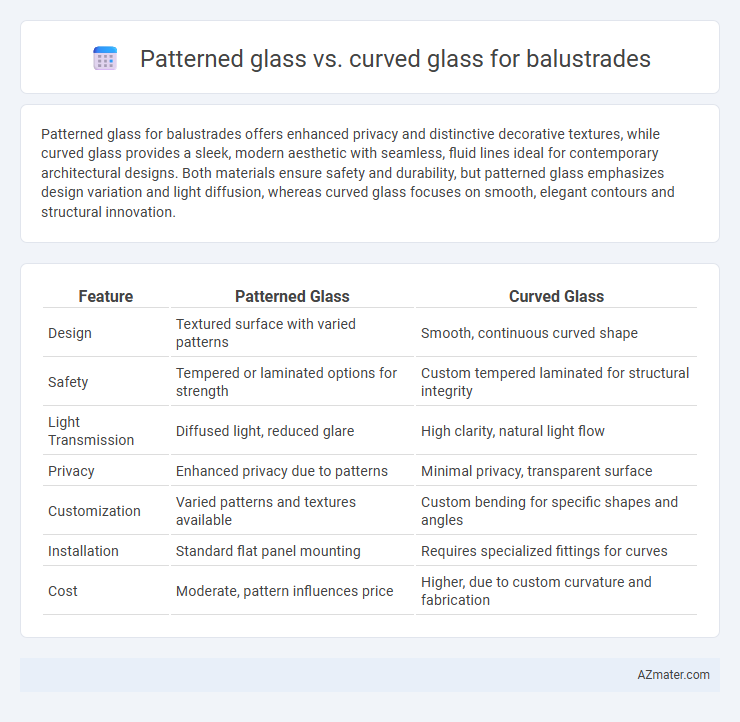Patterned glass for balustrades offers enhanced privacy and distinctive decorative textures, while curved glass provides a sleek, modern aesthetic with seamless, fluid lines ideal for contemporary architectural designs. Both materials ensure safety and durability, but patterned glass emphasizes design variation and light diffusion, whereas curved glass focuses on smooth, elegant contours and structural innovation.
Table of Comparison
| Feature | Patterned Glass | Curved Glass |
|---|---|---|
| Design | Textured surface with varied patterns | Smooth, continuous curved shape |
| Safety | Tempered or laminated options for strength | Custom tempered laminated for structural integrity |
| Light Transmission | Diffused light, reduced glare | High clarity, natural light flow |
| Privacy | Enhanced privacy due to patterns | Minimal privacy, transparent surface |
| Customization | Varied patterns and textures available | Custom bending for specific shapes and angles |
| Installation | Standard flat panel mounting | Requires specialized fittings for curves |
| Cost | Moderate, pattern influences price | Higher, due to custom curvature and fabrication |
Introduction to Glass Balustrades
Glass balustrades enhance architectural aesthetics by combining safety with transparency, utilizing both patterned and curved glass types for distinct visual effects. Patterned glass offers textured designs that provide privacy and decorative appeal, while curved glass enables smooth, flowing forms that complement modern architectural lines. Selecting between patterned and curved glass depends on desired visual impact, structural requirements, and application context in residential or commercial balustrades.
Overview of Patterned Glass
Patterned glass offers enhanced privacy and decorative appeal through textured surfaces that obscure visibility while allowing light transmission, making it ideal for balustrades in both residential and commercial settings. Its variety of patterns, such as rain, fluted, or seedy designs, adds aesthetic versatility and can complement modern or traditional architectural styles. Patterned glass also provides durability and safety when laminated or tempered, meeting industry standards for balustrade installations.
Overview of Curved Glass
Curved glass for balustrades offers a sleek, modern aesthetic combined with enhanced structural integrity due to its shape, making it ideal for architectural designs that require smooth, flowing lines. This glass type is heat-treated and bent to precise radii, providing superior strength and safety compared to flat patterned glass while maintaining transparency and light transmission. Its versatility allows for seamless integration into various settings, enhancing both visual appeal and functionality in staircases, balconies, and terraces.
Key Differences Between Patterned and Curved Glass
Patterned glass for balustrades features textured designs that enhance privacy and hide fingerprints, while curved glass offers sleek, smooth surfaces providing modern aesthetic appeal and added strength. Patterned glass is often flat and molded with intricate patterns, ideal for decorative purposes, whereas curved glass is precisely bent to follow architectural contours, ensuring seamless integration and enhanced safety. The choice depends on desired visual effect, functional requirements, and installation complexity, with patterned glass excelling in ornamental uses and curved glass favored for contemporary, aerodynamic designs.
Aesthetic Appeal: Patterned vs Curved Styles
Patterned glass offers intricate designs and textures that enhance the visual interest and complement traditional or contemporary balustrade styles. Curved glass provides smooth, flowing lines that create a sleek, modern aesthetic, emphasizing architectural elegance and spaciousness. Both options elevate the balustrade's appearance, with patterned glass emphasizing decorative detail and curved glass showcasing seamless form and fluidity.
Safety and Strength Considerations
Patterned glass for balustrades offers enhanced slip resistance and can diffuse impact forces, improving safety in high-traffic areas. Curved glass, while aesthetically pleasing, requires precise engineering to maintain structural integrity under load, often achieved through tempering or lamination techniques for added strength. Both types must comply with building codes, but curved glass typically demands specialized manufacturing to prevent weaknesses along bends, ensuring reliable performance in safety-critical applications.
Privacy and Light Transmission
Patterned glass for balustrades offers enhanced privacy by obscuring visibility while still allowing natural light to filter through, making it ideal for areas requiring discretion without sacrificing brightness. Curved glass, on the other hand, provides a sleek, modern aesthetic with a smooth surface that maximizes light transmission but offers less privacy due to its transparent nature. Choosing between patterned and curved glass depends on balancing the need for visual privacy with the desire for uninterrupted light flow in balustrade designs.
Installation Challenges and Costs
Patterned glass for balustrades requires precise alignment during installation to maintain consistent design flow, often increasing labor time and costs compared to plain glass. Curved glass presents more significant installation challenges due to its custom fabrication and the need for specialized fittings and supports, leading to higher material and labor expenses. The complex handling and transportation of curved glass further contribute to increased overall project costs relative to patterned glass.
Maintenance and Durability
Patterned glass balustrades offer enhanced scratch resistance and conceal fingerprints better, reducing maintenance efforts compared to curved glass, which often requires specialized cleaning techniques due to its shape. Curved glass provides superior impact strength due to tempered manufacturing processes but may show minor surface wear more readily than patterned glass. Both types offer excellent durability, but patterned glass typically requires less frequent upkeep, making it ideal for high-traffic areas.
Choosing the Right Glass for Your Balustrade
Patterned glass offers enhanced privacy and decorative appeal, making it ideal for balustrades in spaces requiring subtle screening and artistic design. Curved glass provides a sleek, modern aesthetic with smooth, continuous lines that enhance safety by reducing sharp edges and improving structural integrity. Selecting the right glass depends on balancing visual style, privacy needs, and structural demands specific to your balustrade project.

Infographic: Patterned glass vs Curved glass for Balustrade
 azmater.com
azmater.com